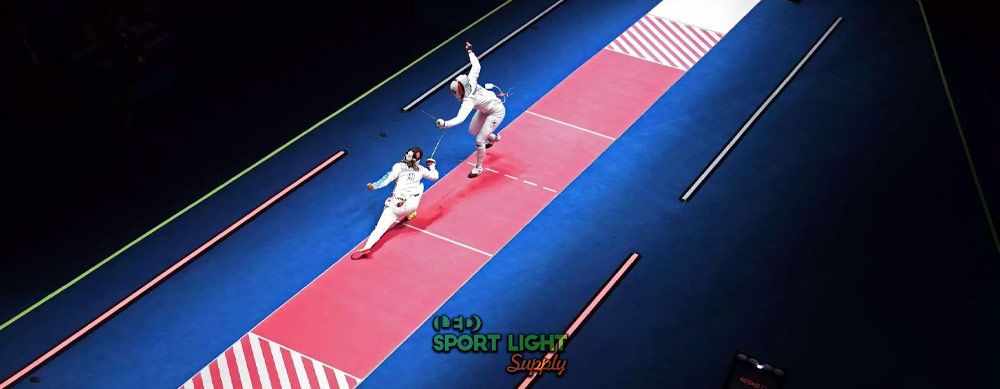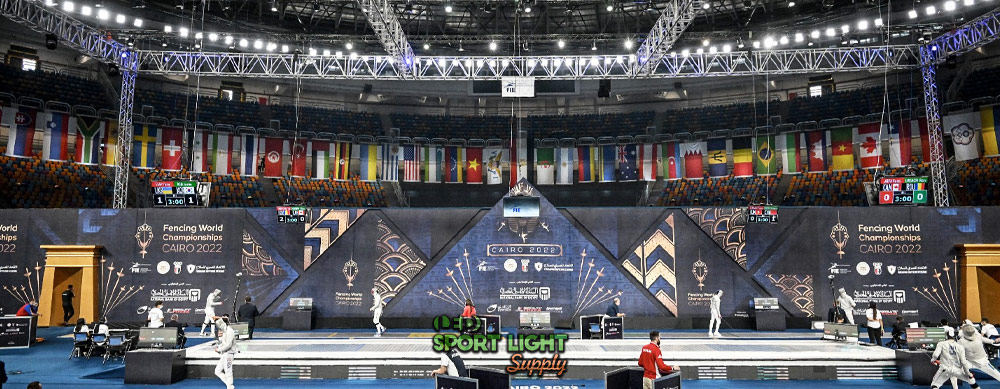Lighting a fencing hall is a complex task that involves meeting several specific requirements, including optimal brightness and uniformity. To achieve the ideal lighting design for a fencing hall, it’s essential to develop a well-thought-out plan. In this article, we will provide an overview of the fundamental concepts and lighting guidelines used for Olympic fencing competitions.
Table of Contents
ToggleLighting Requirements for Fencing Halls and Arenas
Visual Comfort for Fencers

Proper lighting in a fencing hall is crucial for ensuring visual comfort and optimal performance for fencers. The right lux levels allow athletes to see their opponents and the fencing strip with clarity, which is especially important in high-speed fencing matches. The lux requirements differ depending on the level of competition and the type of facility:
| Type of Fencing Hall & Arena | Lux Requirement |
|---|---|
| Recreational & Training | 250 to 400 lux |
| Regional Fencing Competitions | 600 to 800 lux |
| National and International Competitions | Over 1000 lux |
For national and international competitions, where precision is paramount, a minimum of 1000 lux is necessary. This ensures that fencers have a clear line of sight, reducing the chances of errors and enhancing the overall visual experience for both athletes and spectators.
Glare Control in Fencing Hall Lights
Glare is a common issue in fencing hall lighting and can significantly affect a fencer’s performance. It occurs due to the stark contrast between the brightly lit fencing area and the surrounding space. Excessive glare can cause discomfort and even lead to temporary visual impairment, which can be detrimental during a match.
To manage glare, the Unified Glare Rating (UGR) is used. Ideally, the UGR in a fencing hall should not exceed 50, though in certain situations, such as in some international arenas, a UGR of less than 30 may be necessary. If the glare level in your fencing arena is a concern, it’s advisable to consult with lighting professionals to find the best solution.
Installation Height of Fencing Hall Lighting
The height at which lights are installed in a fencing hall is another critical factor. Generally, the lights should be mounted at a minimum height of 4 to 5 meters. In Olympic-standard fencing arenas, lighting fixtures are often installed at heights ranging from 10 to 20 meters. Mounting the lights higher helps reduce direct glare on both fencers and spectators, as well as improving the uniformity of the lighting across the fencing strip.
Given that fencing halls vary in size and dimensions, consulting with lighting engineers is recommended to determine the optimal installation height for your specific venue. Professional guidance can help achieve the best balance between brightness, uniformity, and glare control.
Tilting Angle of the Fencing Hall Lights

The angle at which lights are tilted within a fencing hall plays a significant role in minimizing glare and improving the quality of lighting. The lights should not be directed straight down onto the fencing strip; instead, they should be tilted at an angle, typically between 20 to 60 degrees. This setup reduces the intensity of bright spots on the strip and enhances lighting uniformity.
Additionally, the lights should be positioned so that their surfaces are not visible to cameras used during competitions. This prevents glare from appearing on television screens, ensuring better image quality for viewers.
Multiple Angles to Reduce Shadows
Shadows can be a significant problem in fencing, where visibility of the opponent’s movements is crucial. To minimize shadows, it’s important to position lights at different angles, similar to the way corner light poles are arranged in a soccer stadium. By directing light beams from multiple directions, shadows caused by lights from a single source can be effectively eliminated, providing a clearer and more consistent view for both fencers and spectators.
Advantages of Using LED Fencing Hall Lights
When installing new lighting or replacing existing fixtures in a fencing hall, LEDs are an excellent choice due to their numerous benefits. Here’s a closer look at the advantages of LED fencing hall lights:
High Luminous Efficacy
LED fencing hall lights offer a high luminous efficacy, ranging from 150 to 180 lumens per watt. This means that less wattage is needed to produce the same level of brightness compared to traditional lighting options. For instance, a 400W LED light can replace metal halide lamps of 1000W to 1500W. This efficiency leads to substantial energy and cost savings on power consumption.
Reduced Heat Generation
LED lights are known for their minimal heat output, a significant advantage for indoor environments such as fencing halls. Unlike traditional lighting that generates considerable heat, LEDs maintain a cooler temperature, helping to keep the arena comfortable for both fencers and spectators. This reduction in heat minimizes the need for extensive air conditioning, thereby lowering overall operating costs.
High Color Rendering Index
The color rendering index (CRI) is crucial for accurate color perception in a fencing hall. LED lights with a CRI of approximately 85 to 95 provide vivid and true-to-life colors, enhancing the visual experience during matches. Natural sunlight has a CRI of 100, and while LEDs don’t match this perfectly, they still offer excellent color rendering, which is beneficial for both athletes and viewers.
Long Lifespan
LED lighting boasts an impressive lifespan of around 150,000 hours, significantly outlasting traditional lighting sources such as mercury vapor, halogen, or metal halide lamps, which typically last between 10,000 to 20,000 hours. With LEDs, the need for frequent replacements is greatly reduced, leading to lower maintenance costs over time. Although the initial investment in LED lights may be higher, their longevity and efficiency make them a cost-effective choice in the long run.
Conclusion
LED lighting offers numerous advantages for fencing halls, including high luminous efficacy, reduced heat generation, excellent color rendering, and an extended lifespan. These benefits not only enhance the visual experience for both fencers and spectators but also lead to significant cost savings and lower maintenance requirements over time. Despite the higher initial investment, the long-term advantages of LED lighting make it a superior choice for modernizing fencing hall illumination.
